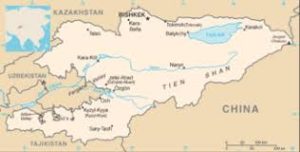 Though Jews were present in the Kyrgz region starting in the 4th century, little is definitively known about their presence in Kyrgyzstan before the Bolshevik Revolution of 1917.
Though Jews were present in the Kyrgz region starting in the 4th century, little is definitively known about their presence in Kyrgyzstan before the Bolshevik Revolution of 1917.
Until 1915, Kyrgyzstan had no synagogues. The country’s small Jewish community congregated in the homes of local rabbis for services. For Jewish funerals, officials from the hevra kadisha, funeral association, were brought from Kazakhstan and Uzbekistan. The only Jewish cemetery was located in Osh; in Bishkek, the Jews had their own section of the Muslim cemetery.
In 1916, groups of Jewish war refugees and POWs from the German and Austro-Hungarian armies were sent to Kyrgyzstan to work in coalmines, irrigation projects, factories, and railroad construction.
In 1920, a Jewish institute focused on ending Sephardic illiteracy was established under the leadership of Simon Dimanshtein. The organization founded a number of primary schools and technical colleges for the preservation of Bukharian culture and language-Persian and Uzbek dialects. Learning circles and clubs were also established. From 1920 to 1940, the Soviets published 750 Persian-Jewish language books and one newspaper in Osh, Bishkek, and Dzhalal-Abad.
 A public synagogue was permitted to open in Bishkek for the first time in 1941 in the city centre. Kosher shops appeared in the neighborhood of the synagogue. In 1945, the city’s Jewish community received official recognition. The Jewish community purchased a building in the center of the city and received a Torah scroll and had a mohel, shochet, hevra kadisha, beth midrash, and mikve. Kosher butchers and bakeries opened nearby. Soon after, synagogues were founded in Osh and Kant.
A public synagogue was permitted to open in Bishkek for the first time in 1941 in the city centre. Kosher shops appeared in the neighborhood of the synagogue. In 1945, the city’s Jewish community received official recognition. The Jewish community purchased a building in the center of the city and received a Torah scroll and had a mohel, shochet, hevra kadisha, beth midrash, and mikve. Kosher butchers and bakeries opened nearby. Soon after, synagogues were founded in Osh and Kant.
The Soviet authorities officially recognized the Bishkek Jewish community in 1945. At that point, 70 members attended services at the Bishkek synagogue daily, 200 weekly, and more than 2,500 on high holy days. The community was allowed to celebrate official Jewish holidays and continue Jewish activities until the 1950s. By 1979, the community had diminished to 6,900, with 5,700 living in Bishkek. In 1989, it had shrunk to 5,800. Today, there are approximately 2,500 in the country. Continued immigration to Israel is the main cause of the decrease in the Jewish population, combined with economic problems and military conflicts in the 1990s. From 1989 to 2001, 4,907 Jews made aliyah and, in 1990, just prior to independence, more than 1,000 immigrated to Israel.
 After the fall of the Soviet Union, many of the nation’s Jews emigrated to either Israel or America. A large portion of those who stayed behind are mostly impoverished and now dependent on community welfare. Three-quarters of the local population is Muslim, yet Kyrgyzstan has little history of anti-Semitism, despite Soviet hostilities and Stalin’s anti-religious raids.
After the fall of the Soviet Union, many of the nation’s Jews emigrated to either Israel or America. A large portion of those who stayed behind are mostly impoverished and now dependent on community welfare. Three-quarters of the local population is Muslim, yet Kyrgyzstan has little history of anti-Semitism, despite Soviet hostilities and Stalin’s anti-religious raids.
Bishkek is home to an Ashkenazi synagogue and several small Bukharan services. A new rabbi came to Kyrgyzstan from Israel in 2000 to head the Ashkenazi synagogue. A number of Bukharan prayer houses are scattered around the Ferghana Valley. There are also Jewish communities in the cities of Osh, Karakol, and Dzhalal-Abad.
Fewer than 70 Jews are thought to live in southern Kyrgyzstan. Most of the country’s estimated 1,500 Jews reside in the capital city of Bishkek. Until the 20th century, most Jews living in the Kyrgyz areas were of the Bukharian Jewish community. However, during the 20th century, large amounts of European Jews began to emigrate to Kyrgyzstan which was then part of the Soviet Union, and a small amount of them still live in the country.